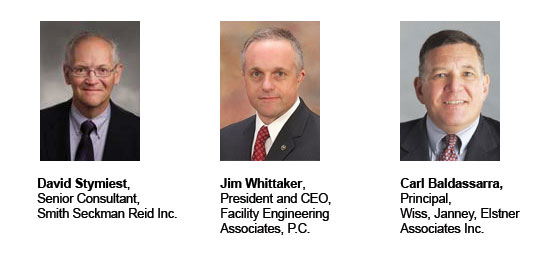Regulations and codes constantly evolve. Consultants offer strategies on how to keep up
By Dave Lubach, Associate Editor
OTHER PARTS OF THIS ARTICLEPt. 1: This Page

Complying with regulations and codes ranks among the highest priorities for maintenance and engineering managers in institutional and commercial facilities. In this roundtable, consultants discuss compliance challenges and the trends and developments they foresee.
How has the task of complying with regulations and codes changed for managers in institutional and commercial facilities?
STYMIEST: The task of complying with consensus-based standards continues to change as regulations and codes continue to evolve. Most consensus-based standards, regardless of the sponsoring organization, are regularly updated to reflect multi-stakeholder input and new lessons learned. Then these updated documents with modified requirements apply to managers when the authorities having jurisdiction (AHJ) with regulatory oversight over those facilities adopt the newer documents.
WHITTAKER: First and probably most obvious is probably the overall complexity today in codes, regulations and standards, compared to where it’s been in the past. There’s certainly a lot more in terms of standards and regulations — a lot broader variation in where things are. There’s certainly a lot more visibility in compliance. A manager today is dealing with not just the environmental, health, and safety aspects of managing facilities but now whether it’s institutional or commercial, they’re dealing in energy, the sustainability, or safety. It’s much more complex.
BALDASSARRA: There are more regulations about existing buildings than there ever have been. Some of the regulations that affect existing buildings are being enforced more uniformly than they have been in the past, and they’re beginning to affect clients who maybe haven’t been faced with that kind of enforcement before. The adoption and enforcement of the International Code Council’s International Existing Building Code is being adopted by a growing number of jurisdictions. There’s also a greater emphasis on safety in commercial buildings than there has been in a long time. That’s a social trend we see — regulations to improve safety are more accepted by the public than they used to be. The inspecting agencies, whether it’s a city or state, or fire department or district, are better educated and trained than they used to be, and that is having an effect.
What are the main challenges for managers to stay updated with regulations and codes?
BALDASSARRA It’s difficult to stay updated unless you’re part of a local trade organization, like Building Owners and Management Association, the American Hotel and Lodging Association, or the American Society for Healthcare Engineering. There are many proposed regulations and codes out there.
STYMIEST: In some fields, such as health care, the main challenges are caused by conflicting codes and standards that cause facilities to waste scarce financial resources. As an example, the Centers for Medicare and Medicaid Service (CMS) is still enforcing the 2000 Life Safety Code 15 years and five editions after that edition was issued by the National Fire Protection Association (NFPA). As if that single code were not enough, all direct and indirect mandatory references from it to other NFPA standards of the same era also apply to today’s health care facilities.
WHITTAKER: The pure volume of laws, regulations and codes. Given the executive orders and standards, as well as the variation and breadth of them, but also the frequency in changes. I don’t think you could have a code expert from a facility management perspective because of the volume of codes and standards out there and the frequency at which they’re updated. Just thinking about the laws and regulation like the Occupational Safety and Health Administration (OSHA) that have been out there now for 45 years, and the Americans With Disabilities Act (ADA), there’s a lot of environmental and sustainability executive orders and regulations centered around energy efficiency. Then you look at ASHRAE, and American Society of Mechanical Engineers, there are literally hundreds in all of these, and the model codes get major updates every three years.
What resources should managers use to keep up with regulations and standards?
STYMIEST: If your field has a national organization of your peers, that organization’s resources can be very helpful. And if that organization has a Listserv for members, that member benefit alone can be very helpful. Some private organizations have excellent newsletters, as well.
BALDASSARRA: Being part of an organization or being on a local committee is a good start. It’s rare to find news stories about pending regulations because they just don’t have the appeal to the general public.
WHITTAKER: I wish there were some better resources. The ones I look to are a couple of really good websites. The International Code Council website not only talks about the adoption and enforcement of model codes on a state-by-state and locality and municipality basis. It provides other really good information. Another one is NFPA, which provides information and updates around all of the NFPA standards, from sprinkler systems to egress to alarm systems and electrical safety from their hundreds of publications. The National Institute of Building Sciences website has building design guide pages that have some good information. Another one I use often is a subscription service called Municode, which goes into municipalities that describe their specific local codes and regulations.
Which areas of compliance traditionally have presented the most challenges?
BALDASSARRA: Life-safety upgrades can be expensive and difficult, especially in buildings where there are hazardous materials like asbestos in the structure. Elevator upgrades can also be expensive and difficult.
WHITTAKER: Obviously, OSHA compliance has always been a challenge. The other is life safety, and that’s just a lot of interpretation when it comes to implementation of the fire codes and standards related to that and buildings. There’s a lot of gray area in interpretations from AHJs and fire marshals. OSHA, if you get into the details of compliance that have been most challenging, for the last 15 years the top 10 list has been pretty consistent. Managers are struggling with things like fall protection, use of scaffolding and ladders, hazardous communication, electrical safety, lockout and tagout, and personal protection. Those kinds of things are always compliance issues that have been pretty challenging.
Which compliance issues are likely to present the biggest challenges in the near future?
WHITTAKER: Today, more codes are dealing with not only requirements for design and renovation but operations and maintenance. You have to provide adequate clearance around these, whether it’s a sprinkler head, alarm system or electrical panels, or even plumbing systems, to be able to maintain these systems. Where I see some big changes are NFPA 70E, which is electrical safety in the workplace. There are a lot of new changes there on the electrical safety side related to arc flash, arc-rated clothing, and personal protection, as well as rating electrical equipment. Those are major changes coming about. The broad range of energy — that’s just a dynamic with everything from federal regulations and all the executive orders of greening government buildings, to ASHRAE 90.1.
BALDASSARRA: There is going to be continuing emphasis on ADA and accessibility upgrades as facilities get altered. The up-and-coming thing is sustainability and conservation. As society evolves in this area, regulations will follow, and we’ll see increasing involvement in new and existing facilities.
STYMIEST: The health care facilities field expects CMS to adopt the 2012 Life Safety Code (NFPA 101) and the 2012 Health Care Facilities Code (NFPA 99) sometime within the next year. Also, many in that field expect CMS to issue enhanced emergency management requirements before the end of 2015.
Related Topics:













